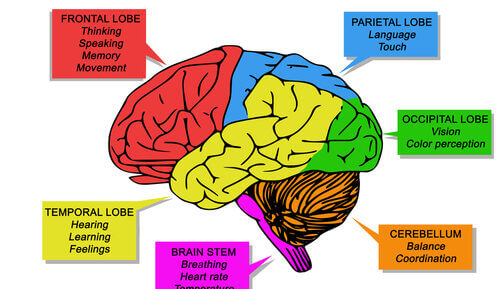
Pick’s disease is a rare form of frontotemporal dementia. These types of dementia affect the frontal lobe and temporal lobe in the brain. The frontal lobes are responsible for memory, motor function, problem-solving, language and judging things such as social situations and whether something is a good idea. The temporal lobes manage speech, listening and also memory. Damage to either of these can dramatically change a person’s behaviour or personality.
In the 1890s, Czech psychiatrist and neurologist Arnold Pick discovered asymmetrical atrophy in the brains of three people with dementia. Atrophy is when cells waste away and die due to not receiving the nutrients they need.
In Pick’s disease, a protein called tau builds up in the brain to form clumps known as ‘Pick bodies.’ These Pick bodies damage neural pathways and cells, causing atrophy and therefore the brain’s ability to function normally. This is the key differentiating factor between Pick’s disease and Alzheimer’s disease – somebody with Alzheimer’s disease has a build-up of both tau and amyloid proteins. Alzheimer’s also affects other parts of the brain, while Pick’s disease only affects the mentioned lobes.
Symptoms of Pick’s disease
People tend to develop Pick’s disease at a younger age (45-60) than those who develop other forms of dementia. The first signs that people with Pick’s disease will notice are changes to speech and/or behaviour. Symptoms include:
- Difficulty finding their words
- Developing a stutter
- Poor grammar
- Smaller vocabulary
- Repetitive actions
- Loss of inhibitions
- Erratic behaviour, such as becoming very impulsive
- Mood swings
- Losing social skills
- Not taking care of personal hygiene or appearance
- Disinterest in activities or in other people.
Testing and diagnosis for Pick’s disease
Unlike most forms of dementia, there is some evidence to suggest that Pick’s disease can be hereditary. Around a quarter of people with the illness inherit the gene responsible. This, along with the earlier age that people develop it, means that those who have a family history of the condition can be aware that they may inherit it and know what to get tested for if they start showing symptoms.
Pick’s disease can be tested for through a neuropsychological assessment. This examines the person’s abilities with memory, speech, problem-solving and understanding of behaviours. They may also have tests such as a lumber puncture, a brain MRI scan or a head CT scan.
Doctors will need to know if the condition is present in the family and may conduct a blood test to decipher this. They may also speak to loved ones about how the person has been behaving and how this differs from their usual state.
Find a care home near you
Treatments and medications
Currently there is no cure or medication for Pick’s disease. The average life expectancy of somebody with the condition is eight to ten years from when they first develop symptoms. While nothing can be done to slow the disease, there are treatments and medications that can ease behavioural symptoms.
Alcohol and Pick’s disease
A danger with Pick’s disease is that because it affects people at a younger age, they can be misdiagnosed.
An American report discussed a woman who was only 25 when she started behaving strangely. While she was eventually correctly diagnosed, one of the behaviours she developed due to the disease was heavy drinking. Alcohol is known to exacerbate symptoms and sometimes even cause dementia. In this woman’s case, many of her symptoms, such as neglecting personal hygiene and poor memory, were accredited to her heavy drinking. In situations like this, it’s crucial to be able to determine a timeline of symptoms.
If you are concerned that a loved one’s behaviour, personality or speech has changed, consult a doctor as soon as possible.
You can also call Dementia UK for support and advice on their free helpline: 0800 888 66 78.


